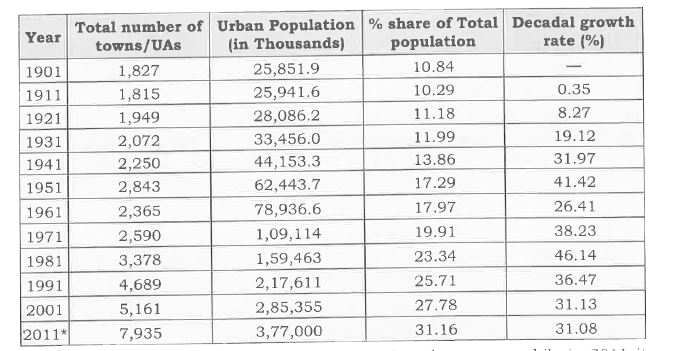Write a note on the adolescent population in India.
Video Solution
Text Solution
An important aspect of population growth in India is the growth of its adolescents. At present the share of adolescents i.e., up to the age group of 10-19 years is about 20.9 per cent (2011), among which male adolescents constitute 52.7 per cent and female adolescents constitute 47.3 per cent. The adolescent population, though, regarded as the youthful population having high potentials, but at the same time they are quite vulnerable if not guided and channelised properly. There are many challenges for the society as far as these adolescents are concerned, some of which are lower age at marriage, illiteracy - particularly female illiteracy, school dropouts, low intake of nutrients, high rate of maternal mortality of adolescent mothers, high rates of HIV/ AIDS infections, physical and mental disability or retardedness, drug abuse and alcoholism, juvenile delinquency and commitence of crimes, etc.
In view of these, the Government of India has undertaken certain policies to impart proper education to the adolescent groups so that their talents are better channelised and properly utilised. The National Youth Policy of Government of India, launched in 2003, stresses on an allround improvement of the youth and adolescents enabling them to shoulder responsibility towards constructive development of the country. It also aims at reinforcing the qualities of patriotism and responsible citizenship. The thrust of this policy is youth empowerment in terms of their effective participation in decision making and carrying the responsibility of an able leader. Special emphasis was given in empowering women and girl child to bring parity in the male-female status. Moreover, deliberate efforts were made to look into youth health, sports and recreation creativity and awareness about new innovation in the spheres of science and technology .
|
Topper's Solved these Questions
- POPULATION : DISTRIBUTION , DENSITY , GROWTH & COMPOSITION BOOK - FULL MARKSCHAPTER - POPULATION : DISTRIBUTION , DENSITY , GROWTH & COMPOSITION EXERCISE - ADDITONAL QUESTIONS SOLVED ( IV. Differentiate Between )
1 Videos
- POPULATION : DISTRIBUTION , DENSITY , GROWTH & COMPOSITION BOOK - FULL MARKSCHAPTER - POPULATION : DISTRIBUTION , DENSITY , GROWTH & COMPOSITION EXERCISE - ADDITONAL QUESTIONS SOLVED ( V. Map Based Questions )
1 Videos
- POPULATION : DISTRIBUTION , DENSITY , GROWTH & COMPOSITION BOOK - FULL MARKSCHAPTER - POPULATION : DISTRIBUTION , DENSITY , GROWTH & COMPOSITION EXERCISE - ADDITONAL QUESTIONS SOLVED ( II. Short Answer Type Questions )
12 Videos
- PLANNING AND SUSTAINABLE DEVELOPMENT IN INDIAN CONTEXT BOOK - FULL MARKSCHAPTER - PLANNING AND SUSTAINABLE DEVELOPMENT IN INDIAN CONTEXT EXERCISE - WORKSHEET
16 Videos
- POPULATION COMPOSITIONBOOK - FULL MARKSCHAPTER - POPULATION COMPOSITIONEXERCISE - Worksheet (Based Chapter -3)
8 Videos
Similar Questions
Knowledge Check
Livestock population in India is
AOver 500 millionB415 millionC350 millionD292 millionHuman population growth in India.
Atends to follow a sigmoid curve as in case of many other animal speciesBtends to reach zero population growth as in case of some animal speciesCcan be reduced by permitting natural calamities and enforcing birth control measuresDcan be regulated by following the national programme of family planningUrban population in India comprises
A0.2B0.27C0.31D0.35
Assertion: The most significant feature of the Indian population is the size of its adolescent population.
Reason: It constitutes one fourth of the total population of India.
View SolutionWrite a note on the New Industrial Policy of India.
View SolutionStudy table 4.1 and write a note on Trends of urbanization in India during 1901 - 2001.

View SolutionWrite a note on tea cultivation in India.
View SolutionThe State with the second largest population in India is :
View Solution
